 W
WAspic is a savoury gelatin made with a meat stock or broth, set in a mold to encase other ingredients. These often include pieces of meat, seafood, vegetable, or eggs. Aspic is also sometimes referred to as aspic gelée or aspic jelly. Aspic is essentially a gelatinous version of conventional soup.
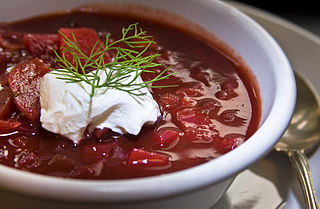 W
WBorscht is a sour soup common in Eastern Europe and Northern Asia. In English, the word "borscht" is most often associated with the soup's variant of Ukrainian origin, made with beetroots as one of the main ingredients, which give the dish its distinctive red color. The same name, however, is also used for a wide selection of sour-tasting soups without beetroots, such as sorrel-based green borscht, rye-based white borscht and cabbage borscht.
 W
WA cabbage roll is a dish consisting of cooked cabbage leaves wrapped around a variety of fillings. It is common to the cuisines of Central, Northern, Eastern and Southeastern Europe and much of Western Asia, Northern China, as well as parts of North Africa. Meat fillings are traditional in Europe, and include beef, lamb, or pork seasoned with garlic, onion, and spices. Grains such as rice and barley, mushrooms, and vegetables are often included as well. Fermented cabbage leaves are used for wrapping, particularly in southeastern Europe. In Asia, seafoods, tofu, and shiitake mushrooms may also be used. Chinese cabbage is often used as a wrapping.
 W
WĆevapi, ćevapčići is a grilled dish of minced meat found traditionally in the countries of southeast Europe. It is considered a national dish of Bosnia and Herzegovina, and is also common in Serbia, Croatia, Montenegro, Kosovo, North Macedonia and Slovenia.
 W
WChebureki is a deep-fried turnover with a filling of ground or minced meat and onions. It is made with a single round piece of dough folded over the filling in a crescent shape.
 W
WChrain is a spicy paste made of grated horseradish. It is a common condiment for meat and fish dishes in Eastern and Central European cuisines. Chrain comes from Yiddish כריין, which is in turn a loanword from Slavic languages.
 W
WChorba or shorba, refers to several kinds of soup or stew found in national cuisines across the Balkans, Central Europe, Eastern Europe, Central Asia, Middle East and the Indian subcontinent. It is often prepared with added ingredients but served alone as a broth or with bread.
 W
WCozonac or Kozunak is a special sweet leavened bread, traditional to Southeastern Europe, Romania, Bulgaria and Serbia, Macedonia, Greece, etc. Rich in eggs, milk and butter, it is usually prepared for Easter in Romania, Serbia, Bulgaria, and mostly for every major holiday in Romania and Moldova. The name comes from the Greek word for hair-коса/kosa, or Greek: ϰοσωνάϰι kosōnáki, a diminutive form of ϰοσώνα kosṓna.
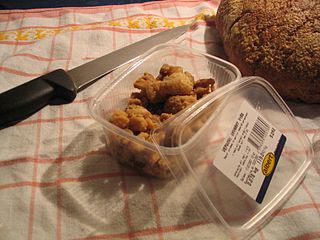 W
WČvarci is a specialty popular in Southeastern Europe, a variant of pork rinds. They are a kind of pork cracklings, with fat thermally extracted from the lard.
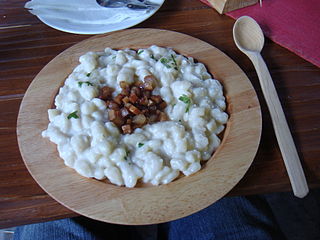 W
WHalušky are a traditional variety of thick, soft noodles or dumplings found in many Central and Eastern European cuisines. Halušky can refer to the dumplings themselves, or to the complete dish. Halushky are a Ukrainian national dish, while Bryndzové halušky is a Slovak national dish.
 W
WGoulash is a soup or stew of meat and vegetables seasoned with paprika and other spices. Originating in Hungary, goulash is a common meal predominantly eaten in Central Europe but also in other parts of Europe. It is one of the national dishes of Hungary and a symbol of the country.
 W
WHead cheese or brawn is a cold cut terrine or meat jelly, often made with flesh from the head of a calf or pig, typically set in aspic, that originated in Europe. Usually eaten cold, at room temperature, or in a sandwich, the dish is, despite the name, not a dairy cheese. The parts of the head used in the dish vary, though commonly do not include the brain, eyes or ears of the animal. The tongue, and sometimes the feet and heart of the animal may be included; the dish is also made using trimmings from more commonly eaten cuts of pork and veal, with the addition of gelatin as a binding agent. Head cheese may also be made without using the flesh from the head of an animal.
 W
WHorseradish is a perennial plant of the family Brassicaceae. It is a root vegetable, cultivated and used worldwide as a spice and as a condiment. The species is probably native to southeastern Europe and western Asia.
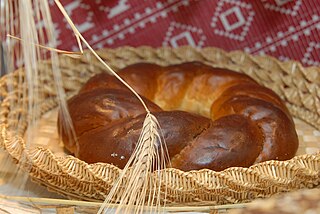 W
WKalach, kalács, kolach, kolač, or colac, is a traditional Eastern European bread, commonly served during various ritual meals. The name originates from the Old Slavonic word kolo (коло) meaning 'circle' or 'wheel'.
 W
WKoliva, also spelled kollyva, kollyba or colivă, is a dish based on boiled wheat that is used liturgically in the Eastern Orthodox Church for commemorations of the dead.
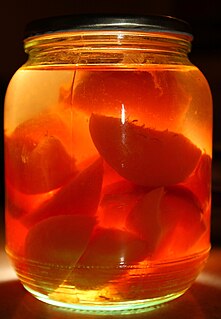 W
WKompot or compote is a non-alcoholic sweet beverage that may be served hot or cold, depending on tradition and season. It is obtained by cooking fruit such as strawberries, apricots, peaches, apples, raspberries, rhubarb, plums, or sour cherries in a large volume of water, often together with sugar or raisins as additional sweeteners. Sometimes different spices such as vanilla or cinnamon are added for additional flavour, especially in winter when kompot is usually served hot. Kompot is popular in Central and Eastern European countries as well as in Southern Europe.
 W
WKugel is a baked pudding or casserole, most commonly made from lokshen or Jewish egg noodles or potato. It is a traditional Ashkenazi Jewish dish, often served on Shabbat and Jewish holidays.
 W
WKürtőskalács is a spit cake specific to the Székelys of Transylvania. Originally popular in the Hungarian-speaking regions of Romania, more predominantly the Székely Land, it became popular in both, Romania and Hungary. The first written record dates back to 1679 and was found in the village of Úzdiszentpéter, while the first recipe appears in a manuscript cookbook dated in 1781. Earlier a festive treat, now it is part of everyday consumption. In Transylvania, a similar pastry to Kürtőskalács is Baumstriezel, originating from the Saxon communities.
 W
WLiverwurst, leberwurst, or liver sausage is a kind of sausage made from liver. It is eaten in many parts of Europe, including Austria, Bulgaria, Croatia, the Czech Republic, Denmark, Finland, Germany, Hungary, Latvia, the Netherlands, Norway, Poland, Romania, Russia, Serbia, Slovakia, Slovenia, Sweden, Ukraine, United Kingdom; it is also found in North and South America, notably in Argentina and Chile.
 W
WMucenici is a Christian feast of the 40 Martyrs of Sebaste, a traditional holiday in Romania and Moldova. It coincides with the start of the agricultural year. Those who observe this holiday clean their households and light fire to their garbage collected from their homes, to bring warmth outside.
 W
WPalatschinke is a thin crêpe-like variety of pancake of Greco-Roman origin. While the dessert is most common in South and West Slavic countries, it is also generally known in other parts of Central and Eastern Europe. Names of the dish include Palaçinka (Albanian), Palatschinke, palačinka, palacinka (Slovak), palačinka (Czech), палачинка, naleśnik (Polish), clătite (Romanian), palacinta or palacinca (Italian) and palacsinta (Hungarian).
 W
WPaska is a Ukrainian Easter bread tradition and particularly spread in countries with predominant Eastern Orthodox religious or cultural connections to the ancient Byzantine Empire. Paska breads are a traditional element in the Easter holidays of Ukraine, Armenia, Belarus, Romania, Russia, Georgia, Moldova and parts of Bulgaria, as well as Turkey, Iran and the Assyrian–Chaldean–Syriac diaspora. Due to its geographical closeness, it is also widespread in Slovakia. Meanwhile, it is also eaten in countries with immigrant populations from Eastern Europe such as the United States, Canada and the United Kingdom.
 W
WPastrami is a Romanian variant of the Turkish pastırma usually made from beef brisket, and sometimes from lamb, or turkey. The raw meat is brined, partially dried, seasoned with herbs and spices, then smoked and steamed. Like corned beef, pastrami was originally created as a way to preserve meat before the invention of refrigeration. One of the iconic meats of American Jewish cuisine and New York City cuisine, hot pastrami is typically served at delicatessens on sandwiches such as the pastrami on rye.
 W
WPierogi are filled dumplings made by wrapping unleavened dough around a savoury or sweet filling and cooking in boiling water. They are often pan-fried before serving.
 W
WPörkölt is a meat stew which originates from Hungary, but is eaten throughout Central Europe.
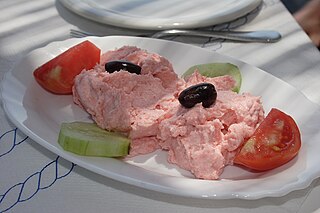 W
WTaramasalata or taramosalata is a meze made from tarama, the salted and cured roe of the cod, carp, or grey mullet (bottarga) mixed with olive oil, lemon juice, and a starchy base of bread or potatoes, or sometimes almonds. Variants may include garlic, spring onions, or peppers, or vinegar instead of lemon juice. While not traditionally Greek, smoked rather than cured cod's roe is more widely available in some places, and often used. Bottarga is usually much more expensive than cod's roe.
 W
WSalceson is a type of meat found in Polish cuisine and other Central and Eastern European cuisines. There are several varieties of salceson which depend on the ingredients.
 W
WSaramură is a traditional Romanian dish, generally based on different kinds of fish, especially in Dobruja, and dried or smoked meat in Moldova and Transylvania. Recipes vary greatly, the common part being fish/meat grilled and afterwards soaked, sprinkled, or boiled in brine or brine-based sauce is added. Usually the dish includes vegetables, mamaliga, polenta, potatoes, etc.
 W
WSarma, commonly marketed as stuffed grape leaves, is a type of dolma—a stuffed dish of the cuisines of the former Ottoman Empire from the Middle East to Southeastern Europe—comprising grapevine, cabbage, monk's rhubarb, kale or chard leaves rolled around a filling of grains, minced meat, or both.
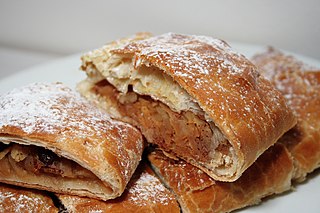 W
WA strudel is a type of layered pastry with a filling that is usually sweet. It became popular in the 18th century throughout the Habsburg Empire. Strudel is part of Austrian cuisine but is also common in other Central European cuisines. In Italy it has PAT recognition, which classifies it as a traditional agri-food product.
 W
WSujuk or sucuk is a dry, spicy and fermented sausage which is consumed in several Balkan, Middle Eastern and Central Asian cuisines. Sujuk mainly consists of ground meat and animal fat usually obtained from beef or lamb, but horse meat is also often used in Bulgaria, Kazakhstan and Kyrgyzstan.
 W
WSummer savory is among the best known of the savory genus. It is an annual, but otherwise is similar in use and flavor to the perennial winter savory. It is used more often than winter savory, which has a slightly more bitter flavor.
 W
WTaramasalata or taramosalata is a meze made from tarama, the salted and cured roe of the cod, carp, or grey mullet (bottarga) mixed with olive oil, lemon juice, and a starchy base of bread or potatoes, or sometimes almonds. Variants may include garlic, spring onions, or peppers, or vinegar instead of lemon juice. While not traditionally Greek, smoked rather than cured cod's roe is more widely available in some places, and often used. Bottarga is usually much more expensive than cod's roe.
 W
WTrdelník is a kind of spit cake. It is made from rolled dough that is wrapped around a stick, then grilled and topped with sugar and walnut mix.
 W
WYakhni, yahni (Turkish), or yahniya is a class of dishes prepared in a vast area from South Asia to the Balkans.